Calgary at War
South African War (1899-1902), World War I (1914-1918), World War II (1939-1945), Korean War (1950-1953)
Despite being known as the Great War, and even “the war to end all war”, the world found itself again embroiled in conflict in September 1939, when Hitler’s army invaded Poland. His Majesty’s Government in London declared war two days later, with Canada following suit within a week (Canada gained independence in foreign affairs in 1931).
Second World War
Tensions were high in Europe prior to the invasion, with Hitler presenting his demands to European leaders. The result was the annexation of Austria and parts of Czechia in 1938. To shore up the Commonwealth, and also to celebrate Canada as a self-governing country, His Majesty King George VI and Queen Elizabeth arrived in Canada in May-June 1939, the first time a reigning monarch of Canada toured the country.
They arrived by rail to Calgary and were greeted by a guard of honour. The next day they arrived at Banff. The first Royal Tour of Canada was a success for both Canadians and the royals. It inaugurated a more modern monarchy, and enthusiastic crowds greeted the King and Queen in every city and town.
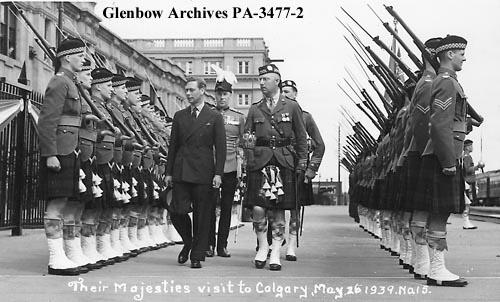
Twenty years after the Great War, Canadians once again were called to defend freedom in Europe. 1.1 million Canadians served in the war, with approximately 42,000 killed and 55,000 wounded.
Calgarians again volunteered to fight.
Princess Patricia’s saw its first major combat when it landed in Sicily during Operation Husky. For two months, soldiers battled in Italy, advancing northward. They went on to participate in the liberation of the Netherlands, becoming the first Allied force to enter Amsterdam.
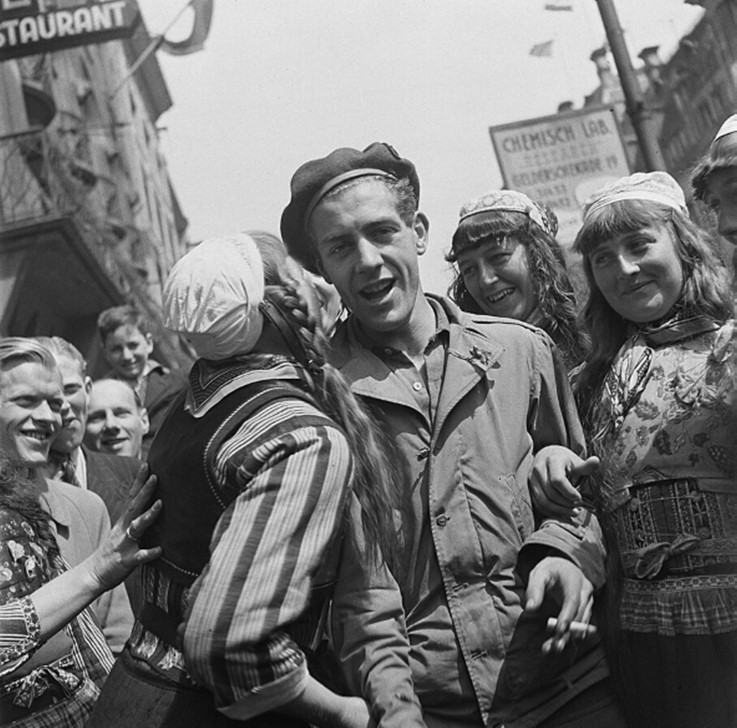
Princess Pat’s were transferred to Calgary after the war and continued serving. On the eve of the Korean War, the battalion volunteered for action and trained to become paratroopers.
During a major Chinese offensive, 700 men of the Princess Pat’s were left to defend Hill 677. They were encircled but held on throughout the night, delaying the Chinese advancement. Seoul was saved from capture and United Nation’s troops regrouped from retreat and pressed a counterattack. For their effort, the units received the United States Presidential Unit Citation.
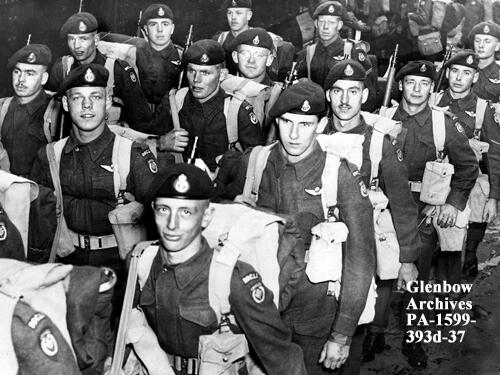
In 1924, the Calgary Regiment had been split into today’s King’s Own Calgary Regiment and the Calgary Highlanders, both headquartered at Mewata Armouries.
The King’s Own Calgary Regiment was the first unit of the Canadian Armoured Corp to go into action at Dieppe, France. The Dieppe Raid was one of the most disastrous days for the Canadian military. Despite heavy bombardment, German positions were concealed and unaffected, which meant they were ready for the tanks and soldiers landing on the beach.
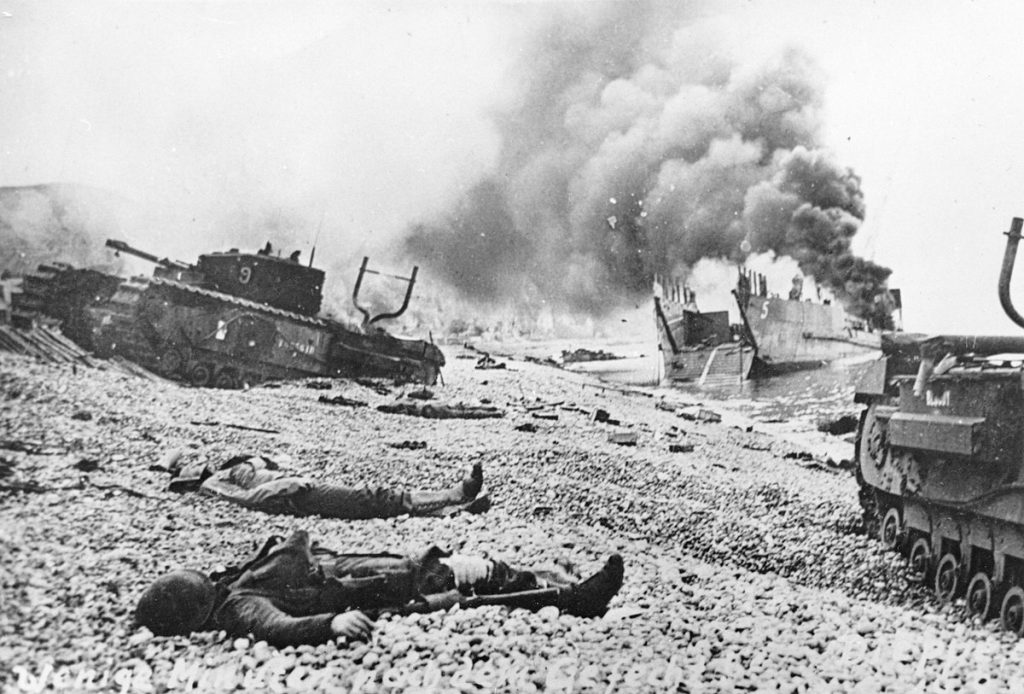
Of the 5000 Canadians serving at Dieppe, 3367 were killed, wounded or taken prisoner. Even though the losses were heavy, the lessons learned helped make D-Day a success.
The regiment was then sent to Sicily, the Italian mainland and France to fight with U.S. Sherman tanks.
For their outstanding service, King George VI granted the prefix “King’s Own” to the Calgary Regiment. After the war, it absorbed the Southern Alberta Light Horse upon their relocation to Medicine Hat.
St. Stephen’s Anglican Church was built in 1951 on the site of the original wooden church of the congregation, first established in 1906. The chapel was dedicated to the King’s Own, and those of the regiment that died in the line of service since many of its members contributed to the church’s building fund. The Romanesque Revival style building was consecrated by the Archbishop of Canterbury and contains the stained glass windows from the original church. It has since been renovated to accommodate theatre performances.
The Calgary Highlanders also took part in the Dieppe Raid and two years later were part of the Allied forces in Normandy, arriving one month after the D-Day invasion in 1944. D-Day occurred on June 6th, also known as Operation Overlord, the Allied invasion of Nazi-occupied France.
The force liberated Dieppe and then went on into the Netherlands, taking the fight all the way to the Rhine River in Germany until the end of the war, Victory in Europe Day (V-E Day), 8 May 1945. Meanwhile, elements of the Southern Alberta Light Horse were part of the 13th Field Regiment, which landed on Juno Beach, the area assigned to Canada as part of D-Day operations.
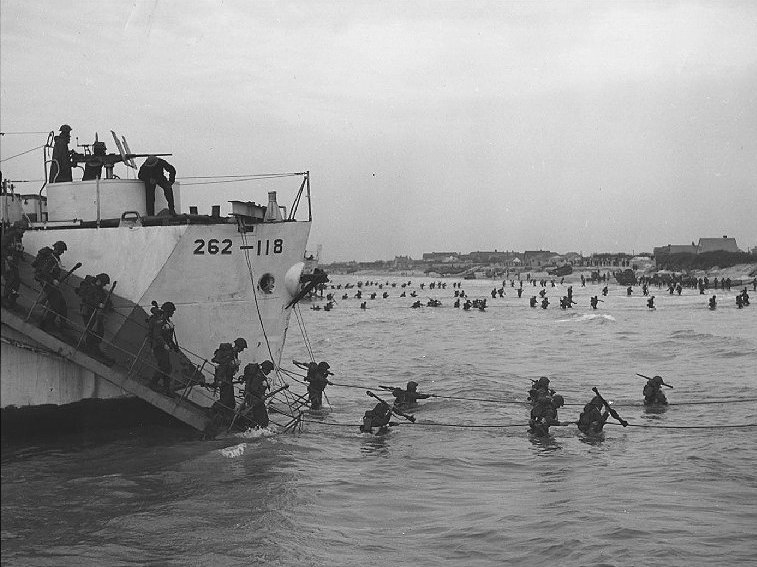
Lord Strathcona’s Horse was mobilized in 1940 as part of the 1st Canadian Motorcycle Regiment. They then became the 2nd Armoured Regiment, training for two years in England on Canadian built Ram tanks. They saw action in Italy, forging their role as a tank unit, before proceeding on to liberate the Netherlands. After WWII, the regiment was deployed to West Germany and took part in the Korean War with the 1st Commonwealth Division.
The war also reached the Rocky Mountains once again when the area was used for internment camps.
After the Allied invasion of North Africa, captured German soldiers were sent to camps in Kananaskis because Britain was unable to house POWs. Members of the Veteran’s Guard were deployed to the camp. Today you can see Colonel’s Cabin, a former forest station from 1936 that was used as the camp commander’s quarters.
Alberta had three other camps during the War, at Wainwright, Lethbridge and Medicine Hat. The latter two were the largest in North America, each capable of holding 12,500 people.
Many Germans, Italians, Japanese and conscientious objectors were held at these camps until the war’s end. Some were Canadian citizens but had been declared enemy aliens. 21,000 Japanese were expelled from B.C. after the bombing of Pearl Harbour for fear of an attack on the Pacific coast, with about 2500 moved to Alberta to work on farms. The government wanted them sent back to B.C. after the war, but then U-turned three years later and invited Japanese-Canadians to stay in Alberta.
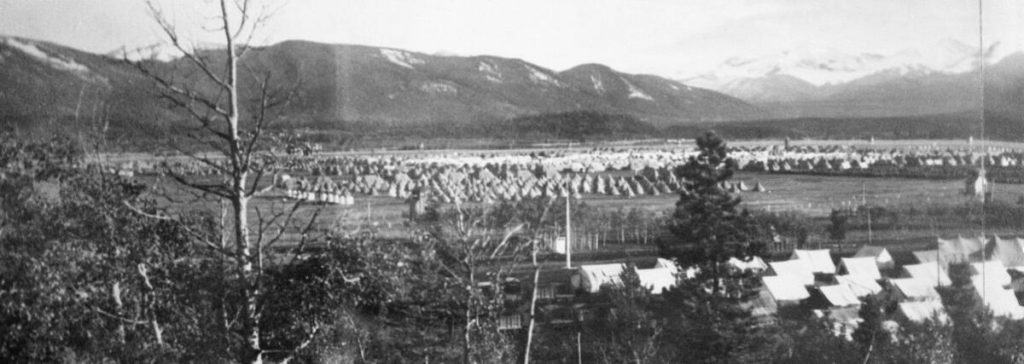
Home Front
Besides the addition of motor vehicles, the airforce played a critical role in WWII, with Alberta the training ground for pilots. In December 1939, the British Commonwealth Air Training Plan (BCATP) was established to train aircrews in Canada. More than 131,000 crewmen and women trained in the program, which was supported by 104,000 Canadians. President Roosevelt went on to call Canada the “aerodrome of democracy”.
Canada was divided into 4 commands, with Calgary the headquarters of No.4 Command. A drill hall was constructed on the site of Calgary’s airport at the time, McCall Field.
Calgary’s first airfield was opened in 1914 in Bowness, complete with grass runway. Old Banff Coach Road Airport opened in 1928, but it was replete with turbulence issues.
A third site was chosen for an airport in Renfrew, Stanley Jones Airport. Renfrew Air operated from Rutledge Hanger, but it folded in 1931 due to the Depression. Experimental mail service to the prairies also occurred here as did daily meteorological readings for weather reports. It then served as a training base during WWII and after the war the area was developed as a residential neighbourhood. Today, Rutledge Hanger is used by the Boys and Girls Club of Calgary and is a provincial historic site.
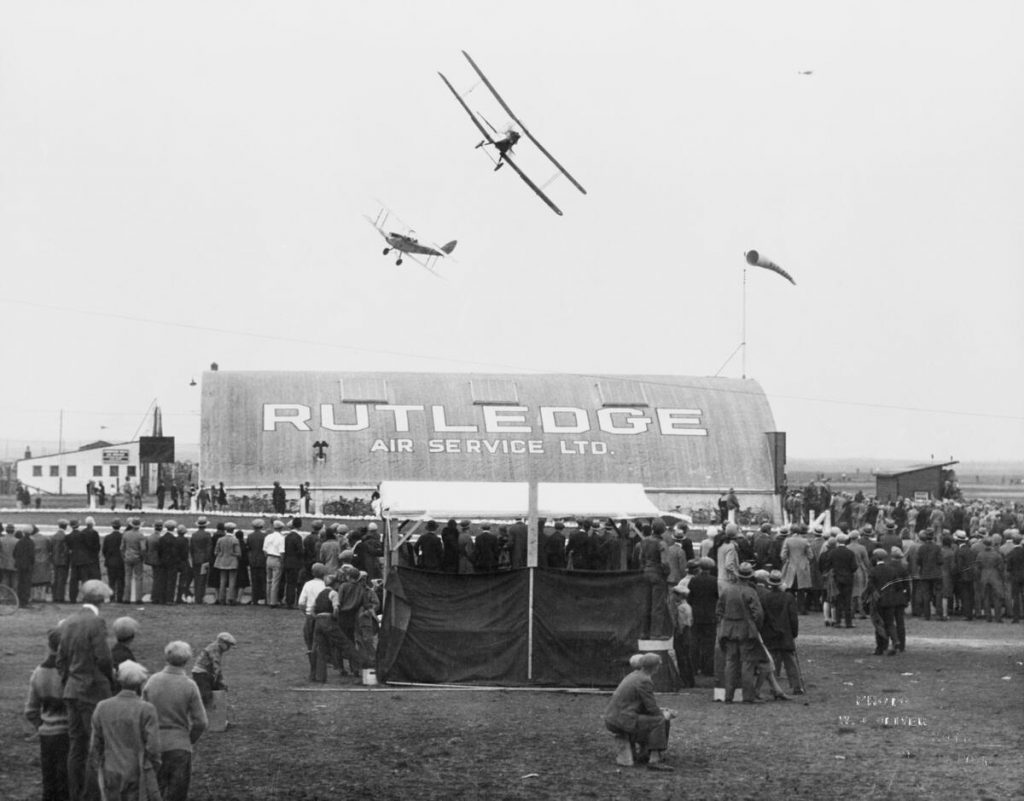
As Calgary grew northward past Renfrew, the city purchased land even further north in 1938, and agreed with Trans-Canada Air Lines to construct a hangar on the site of McCall Field. But who was McCall?
Fred McCall enlisted in Calgary in 1916 and by 1917 had transferred to the flying corps. He went on to become an air ace for his 35 confirmed (and 2 unconfirmed) victories during WWI. During WWII, McCall reenlisted and was a BCATP squadron leader.
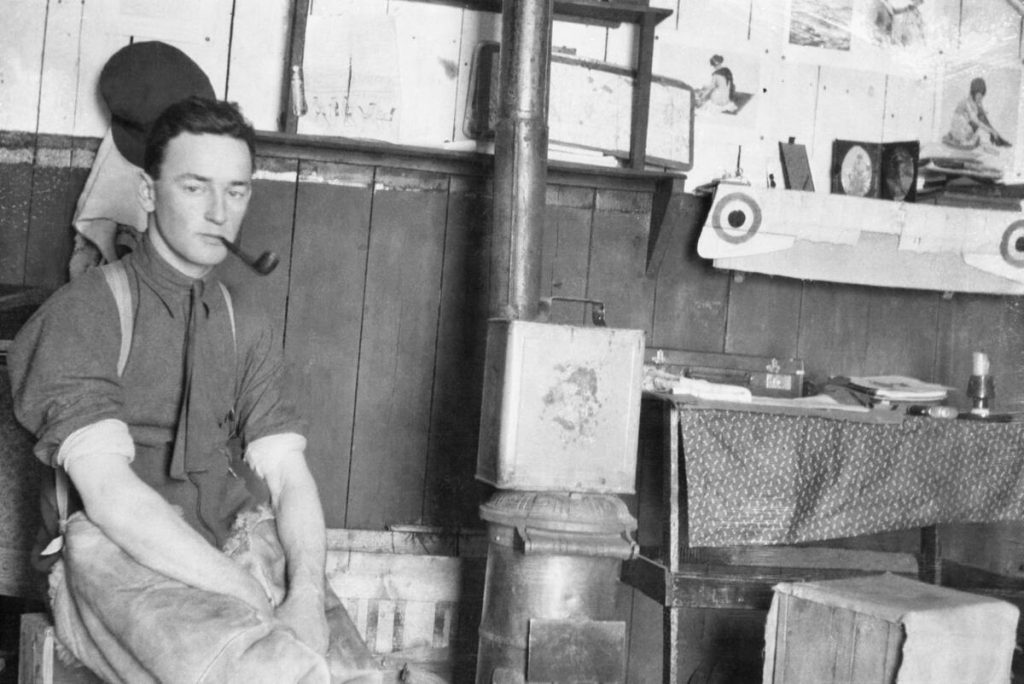
The Drill Hall for the BCATP was built in 1940 at McCall Field, with the federal government assuming control of the airport and repurposed it as a fuel and maintenance stop for training aircraft. The hall housed No.37 Service Flying Training School and was also used for indoor parades during inclement weather.
In 1943, the U.S. Air Force used the airport as a refueling and repair base for flights to and from Alaska. In 1985, the hall was converted for use as the The Hangar Flight Museum and Canada’s Aviation Hall of Fame.
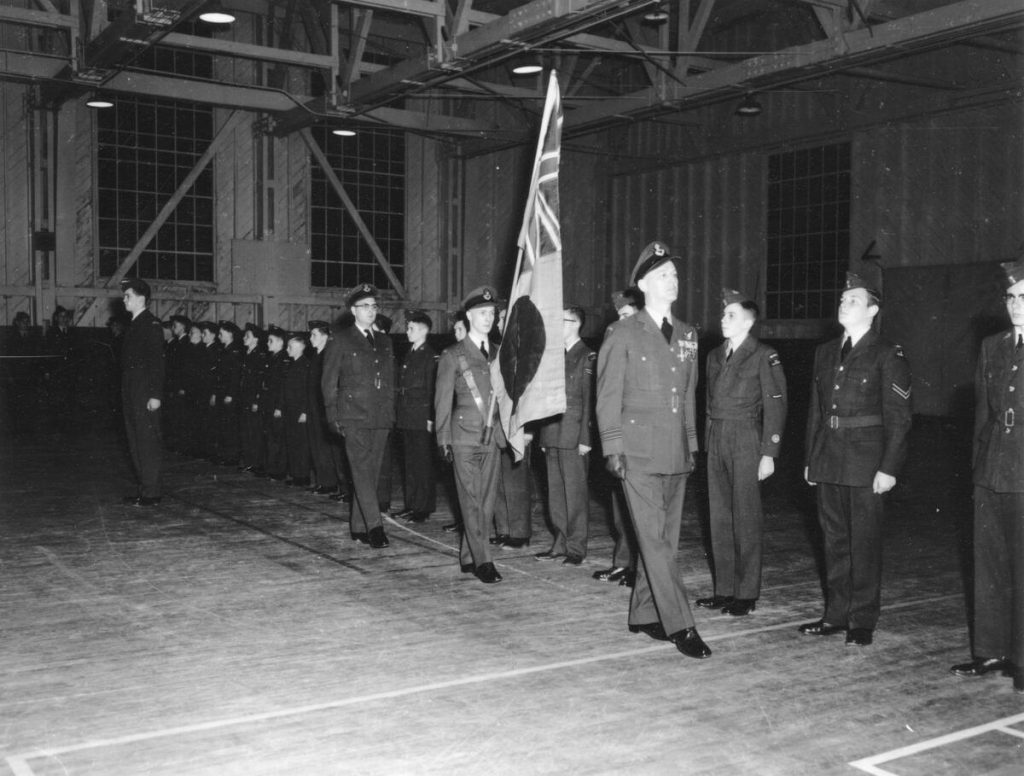
Several BCATP hangars were constructed at Currie Barracks, rare surviving examples of hangars built across the prairies for BCATP. No.3 Service Flying Training School was held here, one of the largest in the Plan. After the war, No.6 hangar was used by Princess Pat’s. In Heritage Hall at SAIT, the No.2 Wireless School trained thousands of radio operators.
The land for a new army base, Currie Barracks, had been acquired by the Canadian Army in 1933. The base was named after General Sir Arthur Currie, who was promoted to command the Canadian Corps, its first Canadian commander, after the success of the Battle of Vimy Ridge. General Currie is considered one of the finest Canadian military leaders. The base trained soldiers for units stationed throughout southern Alberta, and was significantly expanded during the Korean War.
One of the original buildings on the site is Athlone Building. Finished in 1936, it was part of Depression-era public works projects across Canada to create work and upgrade infrastructure. Athlone was the administration headquarters of the base until 1997 and was the first building on Parade Square. After the war, the Army acquired land to the east across today’s Crowchild Trail and constructed hundreds of housing units.
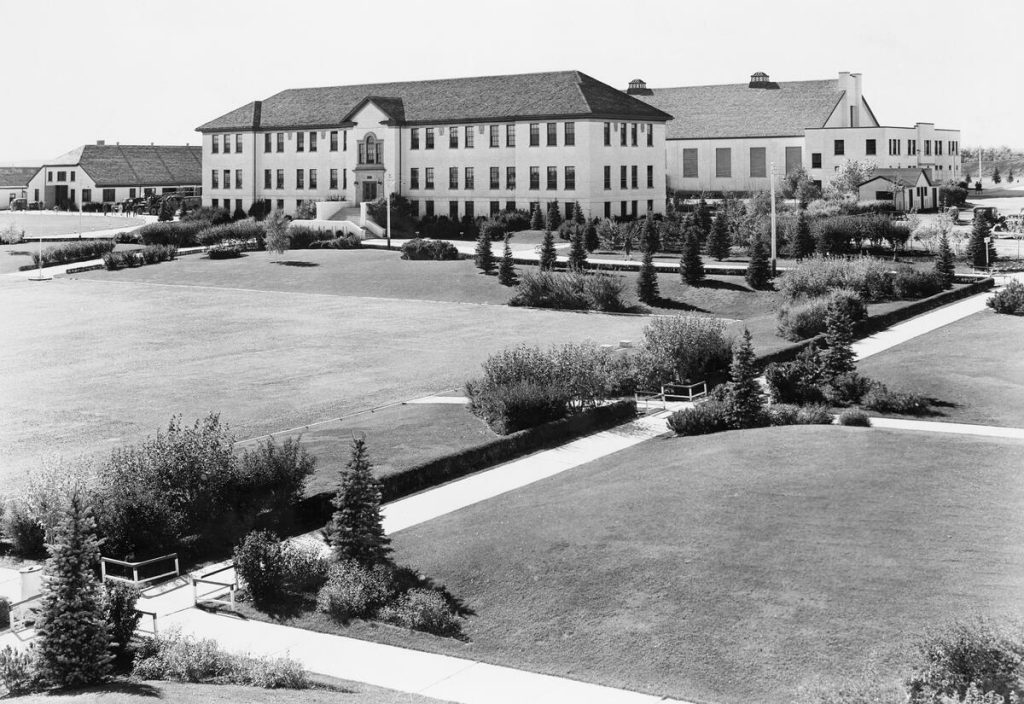
For BCATP, Southern Alberta was ideal for training, with clear, open skies and flat, open prairie. Vulcan, AB was one such community across Canada to experience the boom of air station development and training support during the war.
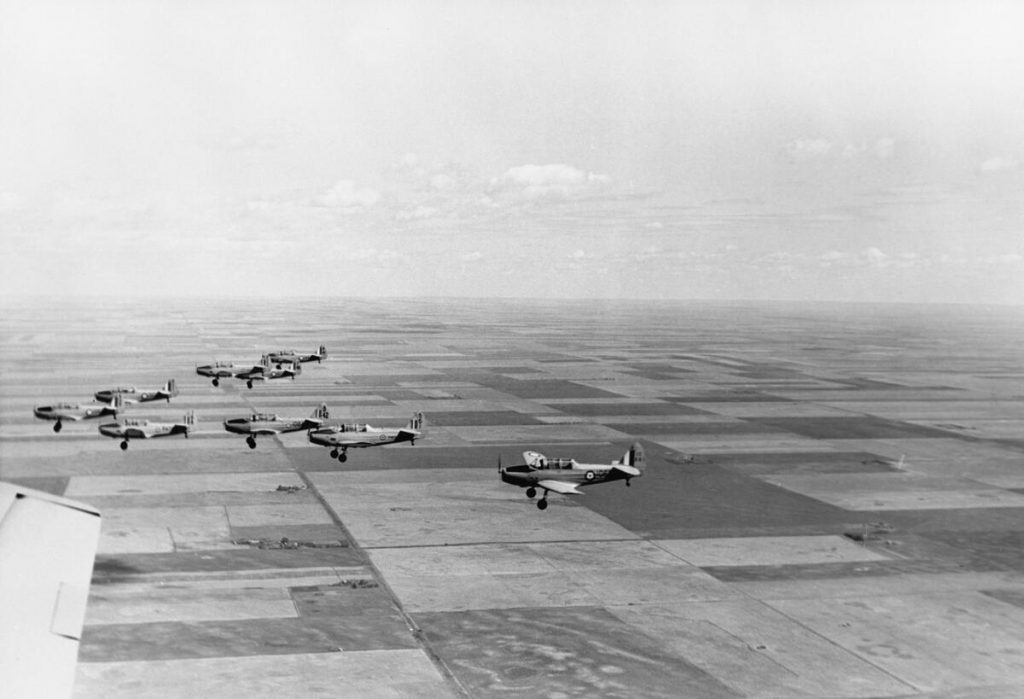
The Royal Canadian Airforce operated Station Vulcan southwest of the town. No.2 Flying Instructor School was held here before moving to Fort Macleod. No.19 Service Flying Training School took over the facility to train bomber pilots.
Today, Vulcan is famous for a different kind of flying. The town was named after the Roman God of Fire by the CPR. Yet fans of the TV show Star Trek took a shine to the name for its connection to the beloved character Spock of Vulcan (played by Leonard Nimoy).
The town capitalized on the show’s fame by constructing a Star Trek-themed visitor centre, replica statue of the Starship Enterprise, and holds an annual convention.
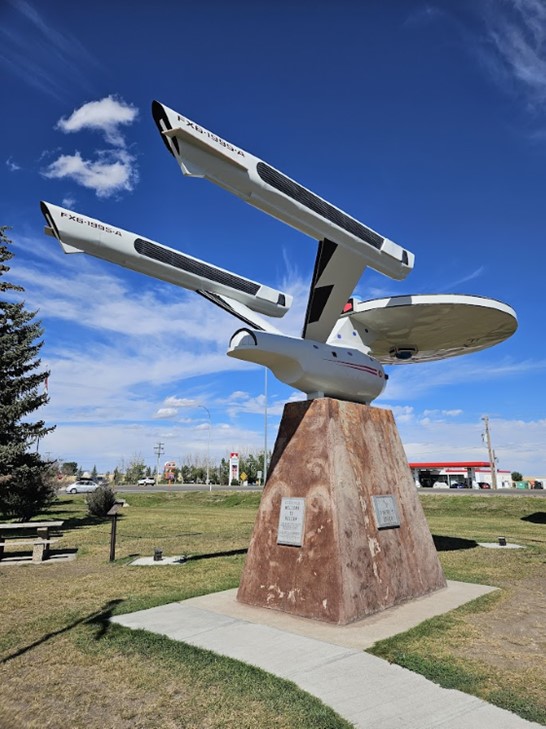
For many years, a bomber plane from the war, an Avro Lancaster, was on display outside in the town of Nanton, AB. The plane was part of the Allied strategic bombing operations against Germany military capabilities. Canada provided No.6 RCAF Group, with 9980 Canadian airmen killed during the war.
In 1985, a group formed to take care of the aging aircraft and they eventually opened the Bomber Command Museum of Canada. It works to restore warplanes and honour those who served in the airforce.
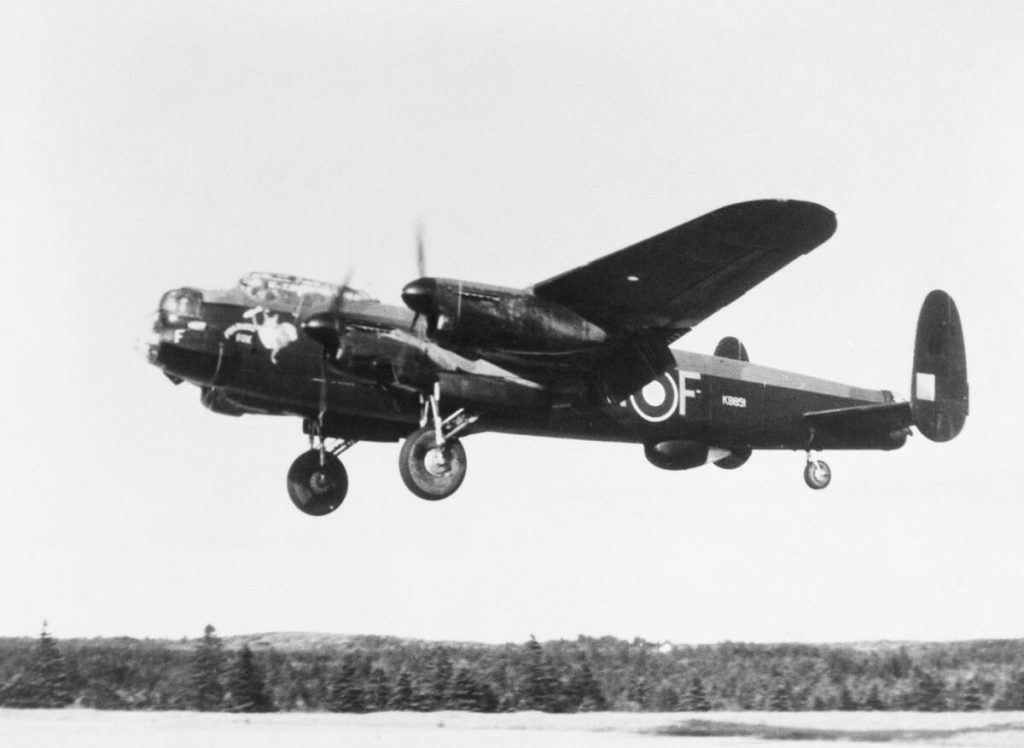
Before turning to the civilian home front, Calgary also plays home to a naval reserve.
HMCS Tecumseh is a “stone frigate”, a land-based unit that supports naval operations, trains personnel and recruits sailors. The reserve was established in 1923 and was christened Tecumseh in 1941.
During WWII, over 4500 personnel enlisted in the reserve, of which 52 were killed in action. One officer, Lt. Robert H. Gray, was the only person in the Royal Canadian Navy to receive the Victoria Cross, and was Canada’s last recipient of the award. As part of the Fleet’s Air Arm, he led a successful air attack on Imperial Japanese naval vessels before dying when his plane crashed into the sea.
Let’s not forget the naval vessel that carries our city’s name, HMCS Calgary.
Two ships have been so named. The first was commissioned in 1941. During the Battle of the Atlantic in WWII, the Flower-class corvette took part in convoy escort duties. She also took part in rescue operations, sank two U-boats, and escaped damage during engagements. The vessel took part in the amphibious invasion of Normandy during D-Day. After the war, it was sold for scrap.
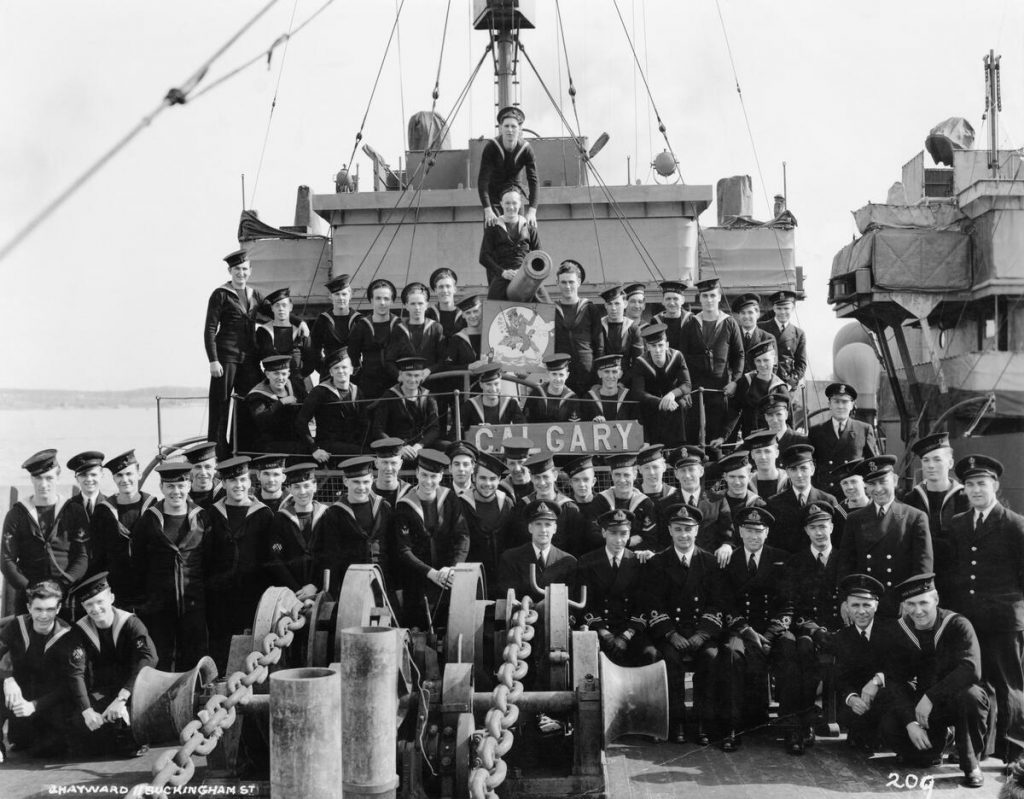
The second ship to bear the name Calgary is a Halifax-class frigate, commissioned in 1995 and still active today. She took part in Persian Gulf operations that year and again in 2003. The vessel is currently assigned to Maritime Forces Pacific, enforcing Canadian sovereignty in our territorial waters and exclusive economic zone, and participating in joint exercises in Asia. Its home port is CFB Esquimalt, near Victoria, B.C.

On the home front during WWII, the impact of the war had the opposite effect of the previous war. While the economy fell during the Great War, the Second World War produced a boom.
To supply the Allied war effort, the Canadian government created Wartime Oils, a crown corporation that provided money for drilling, even in unexplored areas. This enabled riskless drilling, since a company that failed to find oil did not have to repay the investment. In 1942, Turner Valley production peaked at 10 million barrels, but was down to 3 million by 1945. This was the last major boom in the area’s oil industry, with the Turner Valley Gas Plant closing in 1985.
Alberta’s natural gas was used to make aviation fuel for the aircrews training in Alberta and an ammonia plant was built in south Calgary to support munitions programs. At the CPR’s Ogden facilities, locomotive servicing operations were converted to munitions factories. Allied ships fought the war with 4-inch naval guns made in Calgary.
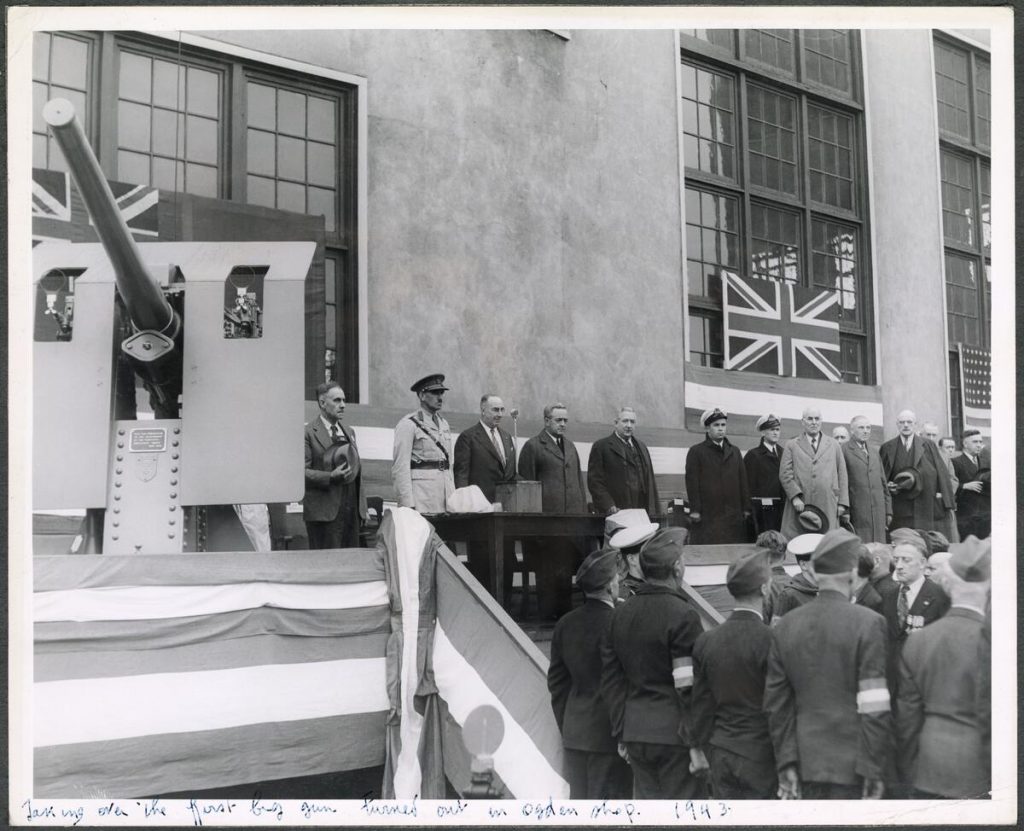
Alberta’s oil was used to finally construct the Alaska Highway. The idea had been proposed in 1929 to strategically and economically link the lower 48 states to Alaska, but the Great Depression delayed investment. President Franklin D. Roosevelt told Prime Minister Mackenzie King that a highway would bolster the U.S.’s defences against Imperial Japan.
It was the attack on Pearl Harbour, HI in December 1941 that got the project off the ground. From Dawson’s Creek, B.C., the highway runs 2700 km (2232 km today due to realignments) through Whitehorse, YK to Delta Junction, AK. Completed in 1942, the highway opened for public use in 1948.
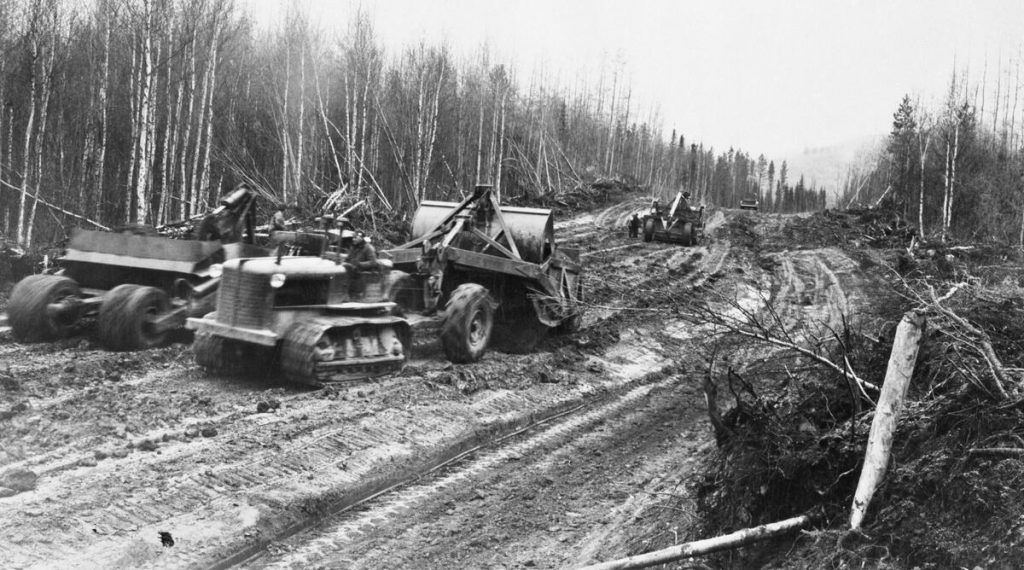
The war was over in Europe on V-E Day and a few months later Japan surrendered, on V-J Day, 15 August 1945. Soldiers returned home. When Calgarians heard of Germany’s surrender, thousands gathered at Victoria Park to hear music by the army band and a bonfire was lit on Scotchman’s Hill.
In Bowness, 48 one acre plots were provided for homebuilding for veterans, an area known as the Soldiers’ Settlement. The development saw Bowness finally grow into the community envisioned by Hextall prior to WWI, with schools and churches being built and two theatres opening in 1947. Bowness was annexed to Calgary in 1964.
At Burnsland Cemetery, a Field of Honour was arranged on land donated by Pat Burns, with each plot marked with the same headstone to illustrate the extent of soldiers’ participation and sacrifice. The Field of Honour includes the Cross of Sacrifice, one of the 26 crosses erected throughout North America, consisting of a stone cross with a symbolic bronze sword.
May they rest in peace.
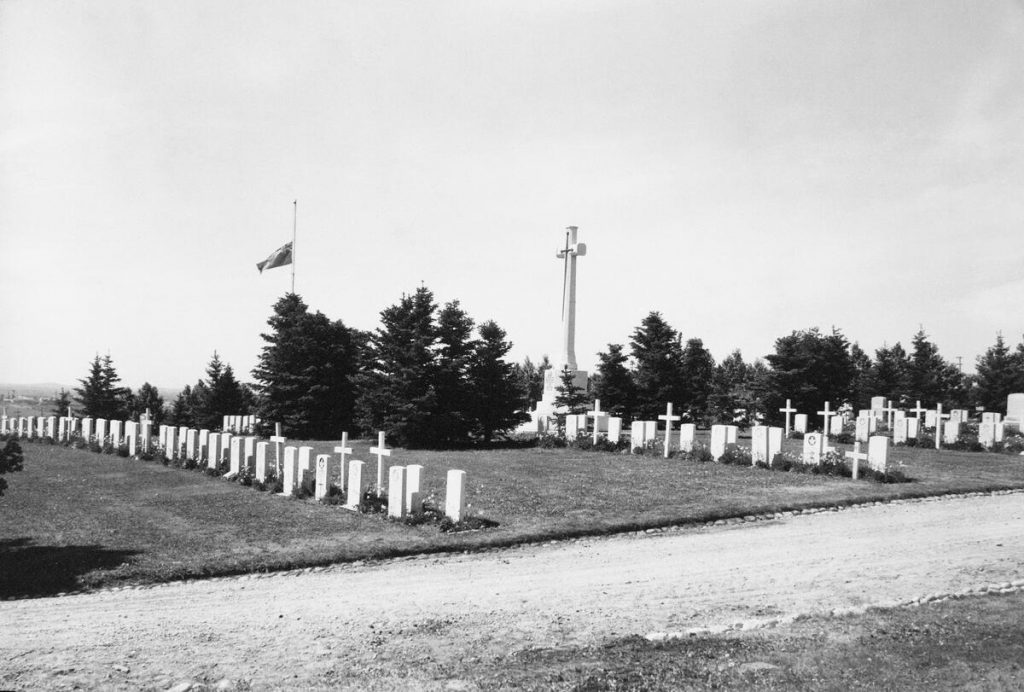
Two years after the war’s end, the discovery of oil at Leduc launched another era of development for Calgary. We’ll take a look next month.
– Anthony Imbrogno is a volunteer with The Calgary Heritage Initiative Society/Heritage Inspires YYC
– All copyright images cannot be shared without prior permission
Where to See this Era
Central Memorial Park, 1221 2 St SW, Calgary, AB T2R 0W9
The Military Museums, 4520 Crowchild Trl SW, Calgary, AB T2T 6E8
- Naval, Army and Air Force Museums of Alberta
- Air Force Cold War Museum
- Lord Strathcona’s Horse (Royal Canadians) Museum
- Princess Patricia’s Canadian Light Infantry Museum
- The King’s Own Calgary Regiment Museum
- The Calgary Highlanders Museum
Canadian War Museum, 1 Vimy Pl, Ottawa, ON K1A 0M8
Canadian National Vimy Memorial, Route départementale 55, Chem. des Canadiens, 62580 Givenchy-en-Gohelle, France
St. Julien Canadian Memorial, Brugseweg, 8920 Langemark-Poelkapelle (outside Ypres), Belgium
Dieppe Canadian War Cemetery, 14 Rue des 4 Vents, 76550 Hautot-sur-Mer, France
14ᵗʰ Army Tank Regiment (Calgary Reg’t) Dieppe Memorial, Bd Maréchal Foch, 76200 Dieppe, France
Tyne Cot Cemetery, Vijfwegestraat, 8980 Zonnebeke, Belgium
Juno Beach Center, Voie des Français Libres, 14470 Courseulles-sur-Mer, France
Imperial War Museum, Lambeth Rd, London SE1 6HZ, United Kingdom
The Hangar Flight Museum, 4629 McCall Way NE, Calgary, AB T2E 8A5
Bomber Command Museum of Canada, 1659 – 21 Ave, AB-2, Nanton, AB T0L 1R0
Commonwealth Air Training Program Museum, 300 Commonwealth Way, Brandon, MB R7A 5Y5
RCAF Aerodrome Vulcan Memorial Plaque, Cadet Flying Training Site, Township Rd 162, Vulcan, AB T0L 2B0
Vulcan Tourism & Trek Centre, 105 Centre St, Vulcan, AB T0L 2B0
CFB Esquimalt Naval & Military Museum, Naden 20 CFB Esquimalt, Esquimalt, BC V9A 7N2
Memorial Drive’s Field Of Crosses (ten days leading up to Remembrance Day), 200 Memorial Dr NW, Calgary, AB T2N 3C2
Calgary Soldiers’ Memorial, Poppy Plaza, 1101 Memorial Dr NW, Calgary, AB T2N 4M7
Field of Honour, Burnsland Cemetery, 3020 Spiller Rd SE, Calgary, AB T2G 4H3
Find your local Royal Canadian Legion Branch at https://www.legion.ca/contact-us/find-a-branch
Video
Canada at War, the NFB’s seminal film series: https://www.nfb.ca/channels/canada-war/
Further Reading
Origins of the Boer War
South African War Memorial and Central Memorial Park
A History of Lord Strathcona’s Horse Regiment
“Stanley Jones: Calgary’s First Great War Enlistee”, Calgary Journal
“How the CPR Changed Our City’s Future”, Calgary Herald
“1939 Royal Tour”, Canadian Encyclopedia
“British Commonwealth Air Training Plan”, Canadian Encyclopedia
Currie Barracks National Historic Site
“POW and Internment Camps in Alberta: WWII”, Retroactive Alberta
A History of Ogden Shops
A History of the Bomber Command Museum of Canada
“No. 2 Construction Battalion”, Canadian Encyclopedia
Battalion Numbers, Signal Hill


Leave a Reply